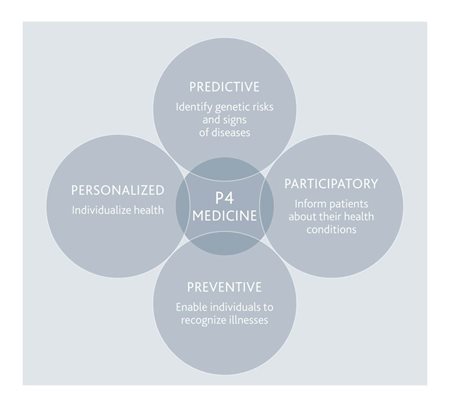
Currently, ageing population is not the only issue the healthcare sector should address. Until now, the pharmaceutical industry has mainly concentrated on developing drugs for patients whose medical problems are already known, and, since all patients tend to receive the same treatment, no real distinction is made between individuals’ specific needs. The question automatically arises though: is it feasible that everyone can get personalized treatment? We believe that the answer is self-evident. Nevertheless, the demand for customized and preventive treatments has been recently increasing. Therefore, another major market trend has emerged in the pharmaceutical and healthcare industry: P4 medicine.
The new market trend presents itself
P4 medicine stands for the transformation into preventive, predictive, personalized and participatory medicine. P4 is a new integrative and interdisciplinary approach that helps detect and prevent various diseases in a timely manner and enhances the well-being of individuals. Through the process, healthcare practitioners are encouraged to consider the simultaneous occurrence of multiple diseases (comorbidity) instead of solely focusing on individual illnesses. Prevention and detection generally occur through close patient monitoring, health coaching, comprehensive testing and frequent analytical evaluation. This approach thus significantly reduces the disease incidence by treating the cause rather than the symptoms of illnesses. Our question is hence the following: How does P4 work and how can organizations benefit from this market trend?
The P4 process relies on digital technology and systems biology, which prevents diseases by predicting organ dysfunctions. To enhance the accuracy and reliability of treatments, a vast amount of data is to be collected, including individuals’ DNA, genome sequencing, blood measurements, physical activity and stress levels, etc. Analysing such extensive datasets makes it possible to provide personalized information and treatments to patients. To better understand the logic behind P4, all four dimensions are scrutinized, as seen in the figure below.
The first P, preventive, refers to tools and measures through which individuals can recognize early-stage diseases. Following a healthy diet, exercising regularly and getting vaccinated when necessary might be among such preventive measures.
The second P, predictive, relates to early diagnosis and identification of (genetic) risks for illnesses through frequent testing and (remote) screening programs.
Then, the third element, personalized, focuses on patients’ individual needs by seeking to optimize medication based on their genetic profile.
Finally, participatory, as the fourth P, involves active participant engagement that strengthens the challenging patient-physician relationship and makes healthcare consumer-driven.
P4 medicine has already begun to change the industry
Most big pharma and biotech companies have already started to address P4 medicine by establishing healthcare biobanks and enlarging patient datasets. Most initiatives so far concern the disease areas of oncology, neurology and cardiology. P4 is also closely related to the emerging market shift, namely digital therapeutics (DTx), which alters companies’ current strategies. Therefore, organizations generally aim to simultaneously address both aspects by launching digital platforms and software focusing on P4 treatments.
Spotlight
 Current Health focuses on continuous patient monitoring and hence highly contributes to the P4 medicine approach. The American organization offers medical devices which enable patients to examine their health from home. These connected devices ensure early diagnosis of chronic diseases and provide preventive care. The “Hospital at Home” approach allows active patient engagement, which refers to P4 being participatory.
Current Health focuses on continuous patient monitoring and hence highly contributes to the P4 medicine approach. The American organization offers medical devices which enable patients to examine their health from home. These connected devices ensure early diagnosis of chronic diseases and provide preventive care. The “Hospital at Home” approach allows active patient engagement, which refers to P4 being participatory.
The future holds high potential to enhance P4 medicine
Although pioneers in science such as biologist Leroy Hood merely began to refer to the term P4 medicine in the early 2000s, this approach is still in its infancy. Nevertheless, this new perspective is revolutionizing healthcare practice by improving treatments and providing cost-effective care, leading to profound economic and social changes, such as new policy statements regarding stakeholder collaboration. Professionals believe that the increasing use of P4 will motivate individuals to carefully monitor their lifestyle choices and thus prevent diseases in the long run. Therefore, it might be inevitable for big pharma firms to address P4 in the near future.
What does your organization expect from this new emerging market trend and are you planning to step in and thus maintain your firm’s competitive advantage in the long term?
Summary
- P4 medicine stands for predictive, preventive, personalized and participatory medicine
- Especially since the pandemic, big pharmaceutical organizations have recognized the advantages of this approach
- Even though P4 medicine is still a young research field, it has a huge potential in the pharmaceutical industry
Outlook
Since P4 medicine is a recently announced initiative, further investigating its practice-oriented purpose and application will be of high relevance in the future. Therefore, pharmaceutical organizations are profoundly interested in how to ensure access to preventive medicine as well as how to motivate patients to actively get involved in their treatments. Furthermore, since corporations tend to engage with (MedTech) start-ups even more, examining how collaboration overcomes challenges like P4 might also be interesting. Since our next post in two weeks evaluates the rising importance of strategic alliances, you might want to check it out!
Author:
Gabriella Panka Hevesi

gabriella.hevesi@bdo.at
+43 5 70 375 - 1250
Abonnieren Sie die neuesten Nachrichten von BDO!
Please fill out the following form to access the download.
